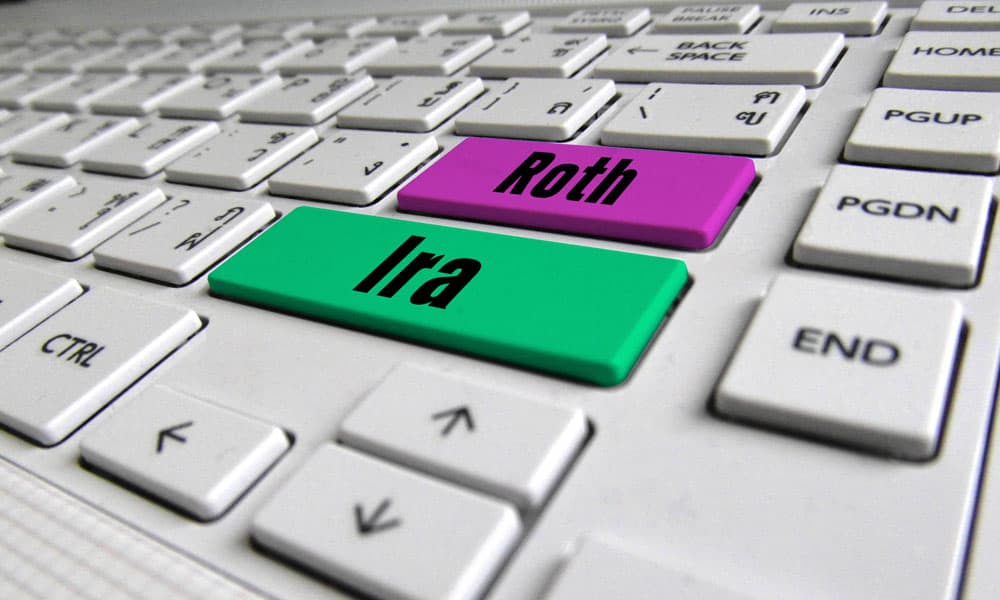

So just what is a Roth IRA and how do Roth IRAs work? Anyone can open a Roth IRA so long as they are earning income from a job, unlike 401(k)s which are offered as a benefit for employees by their employer.
You can open a Roth IRA at any financial institution that offers one. You’re not tied to the bank you have your checking account at, or the company that manages your 401(k). Money in Roth IRAs can be invested in stocks and bonds if you’re aiming for higher returns. Since 1926, a mixture of 70% stocks and 30% has returned an average of 9.1% each year. You can also put the money in a savings account to earn a lower, but safer return.
The intent of a Roth IRA is for it to be used as a place to store money to fund your retirement. Like other retirement accounts, there are limits on how much you can contribute each year.
Here’s how much you can contribute to your Roth IRA each year:
- $5,500 for anyone under 50 years old.
- $6,500 for anyone aged 50 or older.
Roth IRA withdrawals are restricted until you turn 59½.
What’s The Benefit Of A Roth IRA?
What sets a Roth IRA apart from other retirement savings accounts is the type of tax advantage it gives you.
Unlike a 401(k) or traditional IRA, the money you place in a Roth IRA cannot be deducted on your taxes. That means that you don’t see any savings on your tax bill upfront. Instead, the money that you put into a Roth IRA, along with all of the money you earn from investments in your Roth IRA, is never taxed again.
With a traditional IRA, you’ll have to pay income tax when you withdraw, meaning your IRA isn’t quite as valuable as its balance would indicate. With a Roth IRA, you know exactly how much money you have access to.
There’s also a high degree of flexibility as to what type of assets you can hold in a Roth IRA. Some of the best crypto IRA providers can significantly reduce the potential tax burden of holding Bitcoin and other cryptocurrencies long-term.
When Should I Use a Roth IRA?
As mentioned before, you’re limited in how much money you can contribute to a Roth IRA each year. On top of that, the $5,500 limit applies to both traditional and Roth IRAs. You can only contribute $5,500 total across both types of accounts, not $5,500 each.
That leaves you with a difficult choice: do I contribute to a traditional IRA for the immediate savings, or do I contribute to a Roth IRA so I don’t have to pay taxes when I withdraw my money?
The answer depends on your current income, your expected future income, and a bit of guesswork when it comes to the future of the tax code.
If you’re making a lot of money and paying a lot in tax now, but expect to make less in retirement, you can save more by contributing to a traditional IRA and deducting that money from your income taxes.
If you’re making relatively little because you’re early in your career, putting you in one of the lower tax brackets, putting money in a Roth IRA is a good choice. Of course, the future is never certain and changes to tax rates may affect which is the best choice, so which option you choose may be affected by whether you think taxes will be higher or lower in the future.
In general, retirees tend to reduce their expenses once they leave the workforce, requiring that they withdraw less from retirement accounts to support themselves. That makes it easy for a retiree withdrawing from a traditional IRA or 401(k) to keep themselves in a relatively low tax bracket, such as the 15 or 25% bracket.
Though you should base your decision on your personal situation, I decided to contribute to a Roth IRA when I find myself in the 10% bracket for the year, and to a traditional IRA when I’m in the 25% bracket. In the 15% bracket, it’s a matter of personal preference.
Advanced Uses of Roth IRAs
One significant benefit of Roth IRAs that I’ve not mentioned is that they are far more flexible than traditional IRAs or 401(k)s.
With traditional retirement accounts, you have to pay a 10% penalty if you withdraw any money before retirement age. Even if you have desperate need of the money, you’ll take the 10% haircut, then have to pay taxes.
With a Roth IRA, you can get access to your contributions, but not the interest they’ve earned, penalty and tax-free. Any dollar you’ve put into the account can be withdrawn at any time. The one caveat being that once you withdraw the money, you cannot put it back later. Any withdrawal you make permanently reduces your Roth IRA’s balance and cannot be repaid.
The ability to withdraw contributions means that even if you don’t have much money on hand, you can take advantage of the account.
If you have a teenage child who is working to fund their college education, they can place the money they earn in a Roth IRA. When they apply for college, they can withdraw their contributions to pay for school, leaving the earnings to grow tax-free until they retire. With more than forty years for compound interest to work its magic, those few dollars could be worth quite a lot.
Better yet, if they find themselves paying less than expected because they’ve earned a scholarship, they can leave the money in the Roth IRA, allowing the larger balance to grow even faster.
Because the amount you can contribute each year is limited, making sure you contribute as much as possible will help you max out the tax advantages. If you’re near the contribution deadline and don’t know if you’ll need to use the money you have on hand, contribute it to the Roth IRA and keep it in a savings account.
If you need to withdraw the money later, there’s no loss. If you are able to keep it there, you’ve taken advantage of tax benefits you’d have otherwise lost.
Roth IRAs can be powerful tools in the right hands, so knowing when best to make use of one can help you achieve your financial goals as quickly as possible.
Image credit: InvestmentZen Images






























